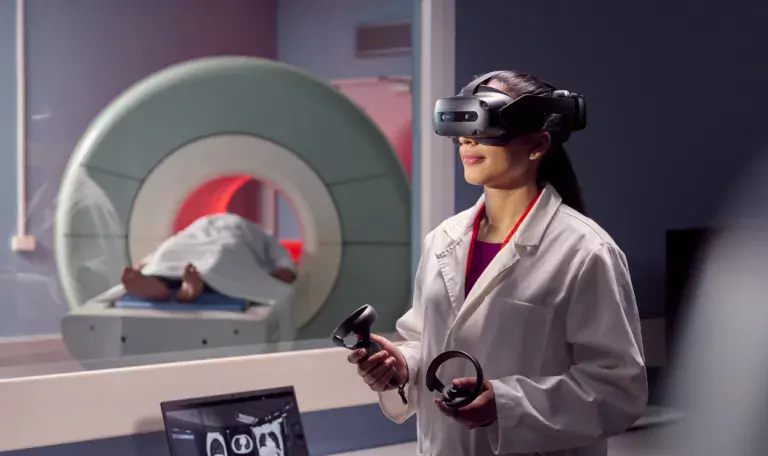The last few years have been transformative for healthcare – from the accelerated adoption of telehealth technologies to the unprecedented expansion of coverage by the Center for Medicare & Medicaid Services (CMS).
While the healthcare industry has traditionally been slow to embrace new innovations, recent events have compelled providers to fully leap over the chasm. As we begin to truly realize the full potential of technology, let’s look at five trends driving care delivery.
Trend #1: Telehealth – It’s Here to Stay
With 38% of care being virtual in 2022,i it is reasonable to hypothesize that telehealth solutions will become as standard as electronic health record (EHR) solutions. According to a report from Bain & Company, virtual healthcare services could climb to 20% of market penetration by 2030.ii
Patients have also embraced virtual appointments. About half of US consumers have attended at least one virtual medical appointment. 48% of them are very satisfied with the experience and would use virtual health again depending on the use case.iii
Trend #2: Expanded Adoption of Virtual Care in Specialized Medicine
The applications for virtual care in specialized medicine are many – from remote management of chronic disease patients to reducing accessibility barriers for patients in need of mental healthcare.
Many people are still choosing virtual visits for their mental health care. A Zocdoc survey conducted earlier this year shows that 87% of appointments in May were virtual compared with 85% in May 2021 and 74% in May 2020.iv
Other specializations that are predicted to expand their use of telehealth solutions include oncology, musculoskeletal health, and behavioral health. As an example, cancer patients who do not live near a specialist will be able to access their care via virtual appointments. Further, some major health systems have already rolled out virtual check-ins so that patients coming in for treatments spend less time in waiting rooms.v Physicians can easily connect with patients across their state or region using flexible technology tools like the ThinkPad T14 Gen 3 for healthcare, powered by Intel vPro® platform.
Trend #3: Payers will Continue to Adjust Reimbursement/Payment Structures to Reflect Current Needs
The past year has seen unprecedented expansion in the coverage of telehealth for Medicare beneficiaries by the Centers for Medicare and Medicaid Services (CMS). As a result of stay-at-home recommendations during COVID surges, CMS added 135 allowable services, more than doubling the number of services that beneficiaries could receive via telehealth.vi
It’s been two years since CMS announced its comprehensive Acute Hospital Care at Home program to increase hospital capacity by shifting the delivery of care for some conditions to patients’ homes. This program was designed for hospitals to monitor and support at-home care for illnesses including congestive heart failure, chronic obstructive pulmonary disease, and acute kidney disease, among others. Altogether, there are 60 acute conditions that CMS has stated can be safely treated at home.vii
These and other programs are expected to continue throughout the coming year. Given the widespread adoption and success of telehealth programs through the pandemic, it is expected that we will continue to see adjustments throughout the coming year.
Trend #4: Expanded Interoperability, Data-Sharing, and Adoption of Consumer Health Technology
The prevalence of technology in healthcare has been critical to managing the country’s health and well-being throughout the pandemic. However, it has also exposed critical gaps including the lack of interoperability and standardization in medical records.
With so much health data still existing in silos, it remains challenging for providers to share information amongst themselves. To achieve the full potential offered through new innovations – like telehealth solutions – the promise of interoperability needs to be realized.viii
These findings are mirrored on the consumer side, with 71% of people indicating they are comfortable sharing de-identified personal health data with their preferred local healthcare system or hospital for various reasons.ix
Expanding data-sharing and interoperability requires powerful and reliable devices and solutions like the Lenovo ThinkStation P360 Tower Workstation with 12th Gen Intel® CoreTM processors.
Trend #5: Every Company will Become Healthcare-focused
With more employees returning to work in -person, the implementation of onsite health and safety programs has become paramount. Companies are introducing onsite clinics, symptom screening technology, and diagnostic testing capabilities to enhance the convenience of and expand access to hybrid care. As a result, local health systems and retail clinic operators are and will continue to face more competition as people opt for convenience and price-transparent care at work.x
Without a doubt, 2022 will go down as another year of rapid transformation and innovation in healthcare. The stage has been set for better healthcare access and delivery over the coming years.
Together with our partners, Lenovo delivers modern IT solutions for a smarter way forward. Let us know how we can help.
Smarter delivers the best experience and insights for employees – onsite or remote – to drive healthcare forward.






